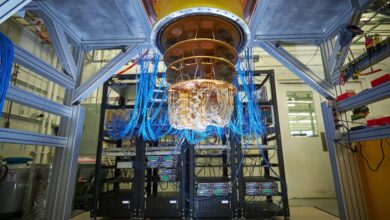Emerging Innovations: Science’s Next Big Discoveries

The world is on the cusp of truly monumental transformations, driven by innovations that currently exist at the thrilling intersection of theoretical science and engineering feasibility, promising to redefine not just technology but the very boundaries of human life and capability.
We are no longer limited to incremental improvements on existing technology; instead, researchers are daring to harness the fundamental laws of nature, from the bizarre rules of quantum physics to the deep complexities within the human cell, to create entirely new industrial and medical realities.
These cutting-edge research frontiers represent the next trillion-dollar economies and the potential solutions to the most challenging global issues, including climate change, incurable diseases, and the limits of computational power, demanding significant investment, multidisciplinary collaboration, and profound ethical consideration.
While still residing primarily within university labs, high-tech startups, and government facilities, these innovations are rapidly approaching the tipping point where they transition from academic curiosities to disruptive, commercial forces, often surprising the public with their speed of deployment.
Understanding these revolutionary fields—including the potential and the inherent risks of technologies like Quantum Computing, Advanced Biotechnology, and Fusion Energy—is essential for anyone seeking to anticipate the future market landscape and grasp the full scope of human scientific ambition.
The research process is slow, expensive, and filled with failures, but the ultimate prize is a transformation of our civilization itself, making this deep dive into the experimental stage an exciting preview of tomorrow.
The Quantum Leap: Rethinking Computation
Quantum Computing (QC) is perhaps the most famous example of a technology still in its research infancy but holding the promise of entirely reshaping computation and information science. Unlike any computer you use today, QC leverages the fundamental, non-intuitive rules of subatomic particles.
1. The Core Physics Behind Quantum
The revolutionary power of QC is rooted in two bizarre phenomena of quantum mechanics that allow calculations to be performed simultaneously and exponentially faster for certain problems.
A. Superposition
- Classical computers use bits that must be a definite 0 or 1.
- Qubits, the basic unit of quantum information, can exist in a superposition of both 0 and 1 simultaneously.
- This means that a quantum machine can represent and process multiple possible states at once.
B. Entanglement
- Entanglement links the fates of two or more qubits together, regardless of the physical distance separating them.
- Measuring the state of one entangled qubit instantaneously influences the state of its partner.
- This correlation allows the computational space of the quantum machine to grow exponentially with each added qubit.
2. Research Challenges and Hurdles
Despite the promise, building a stable, reliable quantum computer is an immense engineering challenge, making this the primary focus of current research.
A. Decoherence
- Qubits are extremely sensitive and prone to decoherence, meaning their fragile quantum states are easily destroyed by outside interference like heat or vibration.
- This instability limits the amount of time a quantum calculation can run before errors creep in.
- Research is focused on developing highly specialized hardware, such as superconducting circuits kept near absolute zero, to maintain stability.
B. Error Correction
- Because qubits are so unstable, quantum calculations are inherently prone to noise and error.
- Creating effective quantum error correction (QEC) codes requires many stable “helper” qubits to maintain the integrity of a single “computational” qubit.
- Researchers must design ways for the quantum computer to detect and correct these errors without collapsing the delicate quantum state.
C. Scalability
- Current prototypes have dozens of qubits, but useful quantum machines (fault-tolerant systems) will require thousands or millions of highly interconnected, stable qubits.
- The difficulty of reliably scaling up these highly sensitive quantum systems remains the single biggest engineering bottleneck.
Energy’s Final Frontier: Nuclear Fusion
For decades, scientists have pursued the dream of Nuclear Fusion—the same process that powers the sun—as the ultimate source of clean, virtually limitless energy.
Unlike nuclear fission (which powers current nuclear plants and creates long-lived radioactive waste), fusion combines atoms.
1. The Science of Sun-like Power
Fusion involves forcing the nuclei of light atoms (usually hydrogen isotopes like deuterium and tritium) to merge, releasing enormous amounts of energy.
A. Creating the Plasma
- To overcome the natural electrostatic repulsion between atomic nuclei, the fuel must be heated to extreme temperatures—over 150 million degrees Celsius—creating a superheated gas known as plasma.
- The plasma must be kept stable and dense enough for the nuclei to collide and fuse successfully.
B. Confinement Challenges
- The primary challenge is safely confining this incredibly hot plasma without it touching the reactor walls, which would instantly cool it down.
- Magnetic Confinement (Tokamaks) uses extremely powerful magnetic fields to contain and shape the plasma in a donut-shaped chamber.
- Inertial Confinement uses powerful lasers to compress and heat a tiny fuel pellet symmetrically and rapidly until fusion occurs.
2. Breakthroughs and Commercialization Research
Recent years have seen significant engineering milestones, bringing the dream of “net energy gain” closer to reality.
A. Ignition Milestone
- Recent research facilities have achieved fusion ignition, meaning the fusion reaction generated more energy than was absorbed by the fuel used to initiate the reaction.
- This was a critical scientific proof-of-concept, but still falls short of net power gain for the entire facility (which includes the energy needed to power the lasers/magnets).
B. Materials Science for Reactors
- Research is intensely focused on developing new advanced materials that can withstand the extreme heat, neutron bombardment, and harsh environment inside a fusion reactor for continuous operation.
- These materials must maintain their structural integrity and not become severely degraded or radioactive over time.
C. Compact Designs and Private Funding
- Private companies are exploring smaller, more compact reactor designs, such as spherical tokamaks or stellarators, hoping to achieve fusion viability faster and more economically than massive government projects.
- This influx of private capital and innovative engineering approaches is dramatically accelerating the overall pace of fusion research.
Advanced Biotechnology: Engineering the Future of Health

Biotechnology is continually pushing the boundaries of what is possible in medicine, with research focusing on manipulating and programming the fundamental building blocks of life itself.
1. Next-Gen Gene Editing and Therapies
While CRISPR has revolutionized gene editing, research is now moving into even more precise and versatile genetic tools.
A. Base and Prime Editing
- Base Editing is a newer technique that allows scientists to change a single genetic letter (A, T, C, or G) without cutting the DNA’s double helix, offering greater precision and fewer off-target effects.
- Prime Editing acts as a “search-and-replace” function for DNA, capable of making a wider variety of genetic changes, including insertions and deletions, with high accuracy.
B. RNA-Based Vaccines and Therapeutics
- Building upon the success of mRNA vaccines, research is exploring ways to use other forms of RNA (like self-amplifying RNA) to program the body’s cells to produce proteins that fight cancer, treat infectious diseases, or repair damaged tissue.
- These platforms are quick to design and scale, making them highly adaptable to emerging health crises.
2. Personalized and Regenerative Medicine
The goal is to move from mass-market treatments to therapies designed specifically for an individual patient.
A. Organ Printing and Engineering
- Scientists are using 3D bioprinting to create complex scaffolds and eventually entire functional organs (e.g., kidneys, hearts) using a patient’s own cells.
- Research is overcoming the challenge of creating the tiny vascular (blood vessel) networks needed to keep large, bio-printed organs alive and functional.
B. Microbiome Therapeutics
- The human microbiome (the trillions of microbes living in and on us) is being intensely studied for its role in health, immunity, and disease.
- Research is focused on developing “smart pills” or engineered probiotic bacteria to deliver drugs, correct immune disorders, or treat neurological conditions by altering the gut flora.
The Intersection of Research: Bio-Sensing and AI
The most fertile ground for future innovation lies where the digital and biological worlds intersect, creating intelligent systems that monitor and interact with living beings.
1. AI in Scientific Discovery
Artificial Intelligence is the indispensable partner accelerating the pace of research in both fusion and biology.
A. Quantum Chemistry Simulation
AI and ML algorithms are used to speed up the complex simulations of molecular interactions, a necessary step before full quantum simulation is viable.
B. Fusion Control
AI is essential for managing and stabilizing the ultra-hot plasma inside fusion reactors, predicting instabilities, and making instant adjustments to the magnetic fields.
C. Drug Candidate Prediction
AI sifts through millions of genetic and chemical data points to predict which compounds are most likely to succeed as drugs, massively accelerating the pipeline.
2. Advanced Bio-Sensing and Interfaces
A. Continuous Glucose Monitoring (CGM)
Research is developing highly precise, non-invasive sensors that monitor biomarkers (like blood sugar) in real-time, sending data to cloud-based AI systems for analysis.
B. Brain-Computer Interfaces (BCI)
BCIs aim to create a direct communication pathway between the brain and an external device, offering potential to restore movement to the paralyzed or dramatically augment human-computer interaction.
C. Electronic Tattoos and Wearables
Flexible, near-invisible sensors are being developed to monitor physiological data (heart rate, hydration, stress levels) with medical-grade accuracy, moving healthcare out of the clinic and into daily life.
Conclusion
The innovations discussed are not yet consumer products, but are in deep research that promises to change everything.
Quantum computing is focused on overcoming immense stability and error-correction challenges.
The pursuit of nuclear fusion energy continues, driven by breakthroughs in plasma confinement and reactor materials.
Gene editing is advancing beyond mere cutting to highly precise base and prime editing techniques.
Regenerative medicine is actively working to print and engineer functional human organs for transplantation.
The development of advanced biotech tools creates critical discussions about genetic equity and ethical usage.
Artificial Intelligence is the crucial accelerator, helping scientists manage and analyze data across all these complex fields.
These research territories will define the next century of human progress and industrial capability.




